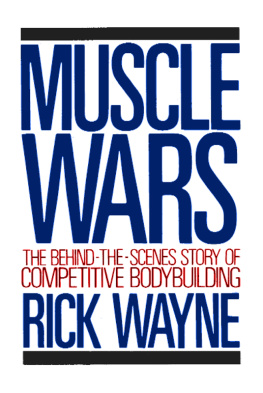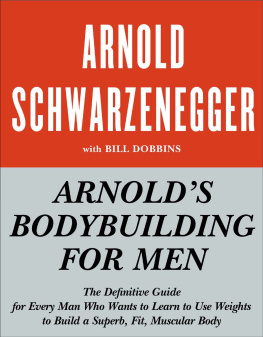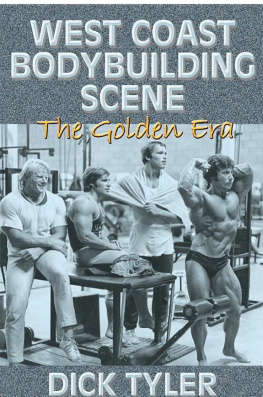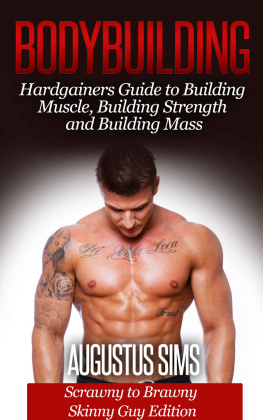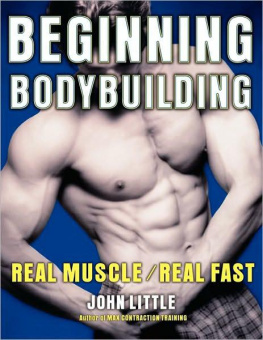ISBN: 9781483508269
ACKNOWLEDGMENTS
Theres been very little tedium involved in the writing ofMuscle Wars. As those whove read my articles and columns over the years will know, I get my own mental pump out of putting pen to paper.
But this book owes its existence to others as well, and I would be remiss if I did not acknowledge their part in it.
Bob Oskam helped make sure the material in the pages that follow would be vintage Rick Wayne. Yes, Virginia, there are editors a writer enjoys working with.
Michael Denneny at St. Martins Press took and held the initiative in piloting this book through publication. He was more than receptive; he was enthusiastic about giving this mans view of bodybuilding (enlightened and totally objective, of course!) an audience in the bookstores as well as around the magazine stands of the world. I thank him for his keen editorial insight.
Thanks, too, to all those who provided me the raw material that went into this book, particularly the score of talented photographers whose pictures you see here. These men have visually chronicled bodybuilding and its personalities over the years. The sport could not have achieved its present worldwide popularity without their dedicated participation. Among the photographers who have lent me the use of their images, Chris Lund, Mike Neveux, George Snyder, and John Balik have been especially supportive, and I thank them doubly for that.
Its been my pleasure over the past twenty years to live and move in a world populated by champions. Ive competed with them. I write of them. For all their foibles and occasional failings, they are for me men of distinction. I could not be what I am today without them.
And Joe Weider. Without him there would be no sport of bodybuilding. That is the bottom line, a point of recognition I find myself always returning to even when I am in disagreement with him. Thanks for the vision, Joe.
Chapter 1
IN THE BEGINNING
My Catholic upbringing notwithstanding, I have long har-bored the devilishly delicious notion that after hed made Eve and let there be light for a delirious Adam, God wafted Himself away from snake-infested Eden to create an earthly heaven that he named The Caribbean.
There is ample evidence supportive of my admittedly pagan conclusion. While each stubbornly clings to its idiosyncratic heritage bequeathed by the first Spanish, Dutch, French, or English settlers the islands of the Caribbean bask blissfully in a basinful of blessings: limpid blue water thats heaven to yachtsmen, skiers, and snorkelers; white sand beaches; and, thanks to soothing trade winds, comfortable year-round temperatures ranging between seventy-five and eighty-five degrees Fahrenheit. From these blest isles have sprung some of the worlds most celebrated bodies: Sergio Olivia (Cuba), Bertil Fox (Saint Kitts-Nevis), Serge Nubret (Guadeloupe), Paul Wynter (Antigua), Earl Maynard, Albert Beckles, Roy Callender (Barbados, all three), Elliott Gilchrist (Grenada), Chris Forde (Trinidad), and Johnny Fuller (Jamaica).
Not that these island people are more health-conscious than their overseas cousins. No, the Caribbean man is simply a product of his natural habitat. His breakfast consists of fresh garden fruit untouched by chemicals, eggs from corn-fed, homegrown chickens, and cassava bread, made from manioc, a close relative of the sweet potato. Coffee break means time for a glass of refreshing, mineral-rich coconut waterfrom fresh green coconut. Lunch is steamed fresh fish with yams, boiled pumpkin or sweet potato, and fresh green salad dressed with olive oil and vinegar. (Stewed or baked chicken is a Sunday dish; red meat, very expensive, is only for special occasions.) Dessert will be a piece of sugarcane or whatever tropical fruit is in season. Supper, served around six p.m., closely resembles lunch.
Since television is still fairly new to the region, few locals take their entertainment sitting down. Fun is movement: foot races at the beach, canoeing, sailing, or dancing through the night to sensuous calypos rhythms, fueled by the vibrations of ones partner and heady Mount Gay Rum.
And evidently it all does a body good.
What a gleaming Porsche is to the Beverly Hills predator, what GQ gladrags and Pierre Cardin jewelry are to the cool New York dude, so is a fine-tuned physique to the Caribbean man and woman. Caribbean youngsters learn early that nothing else matters as much as the successful conclusion of the hunt; that the difference between bagging a bird and having it fly into someone elses bush often has everything to do with the hunters physique. Bright pigments and imaginative wear are no measure of a persons vitality. A bloated, flabby, neglected body, loosely wrapped in dry, dead skin, indicates a sluggish mindand limited sexual endurance.
A mans body is his love instrument. And instinctively he learns to care for it; to keep it muscular and rock hard. His woman is just as body-conscious. Where she is concerned the most important word in the English language is tight!
Caribbean people are born narcissistic.
Even so, in the Caribbean of my youth, on my native Saint Lucia, at any rate, there were no gyms. There were no organized fitness classes, no seminars on health and nutrition. My first body-building lessons came in the form of a correspondence course on dynamix tension. Id seen the authors advertisements in all the American comic books I so avidly read in my preteens. They appealed to my presumed atavistic for self-preservation. After all, if there was one commodity guaranteed never to run out in Saint Lucia, it was sand. Who could be sure some heavy-footed numbskull wouldnt one day take it into his bully head to score points by kicking a load into my face.
Unfortunately, instruction in dynamic tension cost much more than I could spare from my weekly allowance, so I was forced to reconcile myself to defenseless ignorance until such time as I could afford enlightenment.
I didnt have to wait long. I had barely turned twelve when a friend presented me the ten or twelve chapters that held the secrets of machomanhood, as revealed to Mr. Charles Atlas during visits to the various New York zoos, where to his surprise he discovered that the powerhouses of the animal worldgorillas, tigers, bears, lionsnever lifted a barbell! All they aver did was tug at the iron bars on their cages, push against immovable walls, and stretch out on the floor. Yet these beasts displayed an impressive stretch and development that made the days most celebrated strongmen look like lumpy Lilliputions.
Mr. Atlas built on this insight to develop his dynamic tension training system, and rebuilt himself into a macho man capable of hauling freight trains over lengths of New York railroad track. (There were aesthetic benefits, too; he modeled for some of the citys more famous nude statues.) And then he offered the benefits of his experience to the worlds weaklings, promising them failsafe protection against sandy eyes. I was a beneficiary of dynamic tension, albeit not nearly to the extent demonstrated by its originator. However, by the time I was fourteen, my friends had convinced me that I more than merited the two-foot-high statuette Mr. Atlas awarded his successful students. Alas, even though I kept my long-distance trainer abreast of my progress, he gave no evidence of being impressed. In any event, my tin muscleman never arrived.
Just when Id become bored with pitting my right biceps against my left, copies of Strength & Health began to reach Saint Lucia. And there was the evidence I needed to prove Mr. Atlas was less than honest when he wrote that barbell training was only good for turning normal people into overdeveloped aberrations. The men pictured in Strength & Health
Next page
